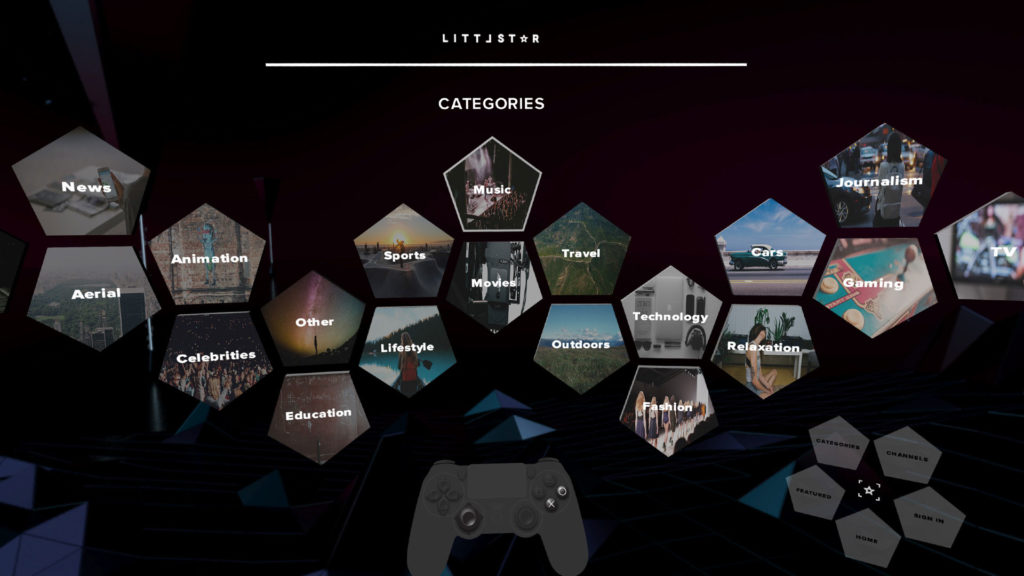Gamers powered up Sony Interactive Entertainment’s PlayStation VR on October 13, and one of the primary apps they found on the device was Littlstar VR. PSVR is the latest platform for the Disney-backed company, which is also available across Oculus Rift, HTC Vive, Samsung Gear VR, Apple and Android devices. And it also aligns perfectly with the app’s users. “Sony sees Lilltstar as a global launch partner, and we’re one of a handful of companies that has that honor,” Tony Mugavero, founder and CEO of Littlstar, told [a]listdaily. “Our core demographic naturally gravitates towards gaming anyway. With the PSVR app, we’ve reworked the interface to have top-level channels that are branded mini experiences.”
Mugavero points to the Wargaming VR Room as a great example of content designed for gamers. While a lot of game companies have been focused on making games in VR, Wargaming is one that has leaned in on 360-degree video and used that as a great tool for marketing and doing mini-documentaries involving World War II history. “We’re highlighting Wargaming as a top-level channel so that viewers will see something that’s familiar to them in the gaming world, but is also great content,” Mugavero said. “We’ve tried to curate VR content toward the gaming demographic, but we’re also starting to show a broader range of content.”
Mugavero said there will be additional 360-degree content around at least one big game franchise launching this year on Littlstar, but he can’t reveal the game yet. “Not everyone will have a high-end PC, so game companies are figuring out 360-degree content for games through in-game footage, trailers and live action content,” Mugavero said. “There are a number of things coming.”
Having the app on every PS VR will guarantee eyeballs for marketers. “We’re having conversations with game companies about content and we’ll start to see more game marketing coming from 360-degree video, particularly now that Nvidia has opened up its graphics cards to import 360 video,” Mugavero said.
Mugavero believes Sony will see similar patterns that have emerged on PlayStation 4, where more people are using the console to consume non-gaming entertainment across streaming services like Hulu and Netflix, as well as Twitch and YouTube. “We have (VR) content from Showtime with boxing and sports-related stuff, Discovery has some great content from Shark Week and ABC is another top-level channel with interesting content,” Mugavero said. “There’s a new company, Mandt VR, that has some incredible stuff that’s really funny and edgier. It’s like what you’d see on TruTV and it’s faster-paced and great for a younger audience.”
Bento Box is a featured channel, although right now it just has a Bob’s Burger VR experience. “They’re working on a bunch of things and they’re leaning in heavily on the VR side of things,” Mugavero said. “We’re also working with them on a broader animation vertical. They have a bunch of things coming down the pipe. The animation side of things is a huge opportunity in VR. Bento Box is just a little behind because they had to modify the pipeline to work in VR because it’s hand-drawn.”
Littlstar recently worked with Universal Music on a One Republic virtual reality music video. And the company also inked a deal with Sony Music Japan to explore virtual reality opportunities involving artists. “Music content is heating up pretty quickly,” Mugavero said. “We’ve seen some pretty impressive music videos in VR. We’re also working on behind-the-scenes content to get up close and personal with the artist. We helped Warner Music with the production of a 30-minute concert film/documentary from Disturbed, which was shot at Red Rock in 360-degree video.”
There’s also a lot of interest from brands and sponsors that want to get involved in 360-degree content, according to Mugavero. “A lot of early content around 360-degree video has been brand-sponsored,” Mugavero said. “We’ve been approached by a number of brands interested in boosting their content to the top of our premium placement across all of the apps. We have a number of pieces coming in from outlets like the Discovery Channel where the brands are baked right into the content. There are revenue shares created around that type of content. It’s more like a traditional manual ad sales approach because the space is so new. There’s no VR ad network, really. And it’s difficult to run programmatic VR advertising to a couple million headsets. So a lot of opportunities are around branded content and having Littlstar provide a boost to watch that 360-degree content across multiple devices.”

